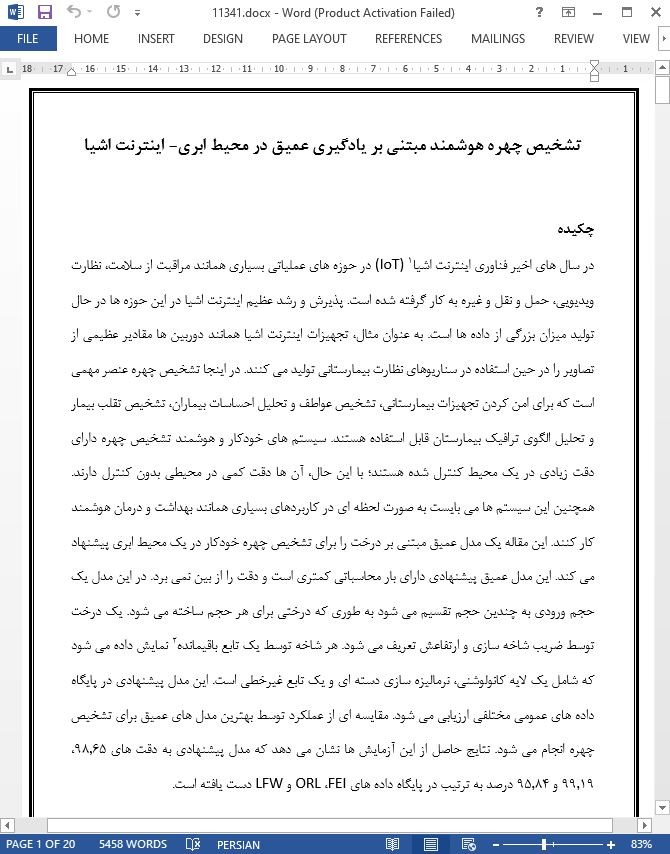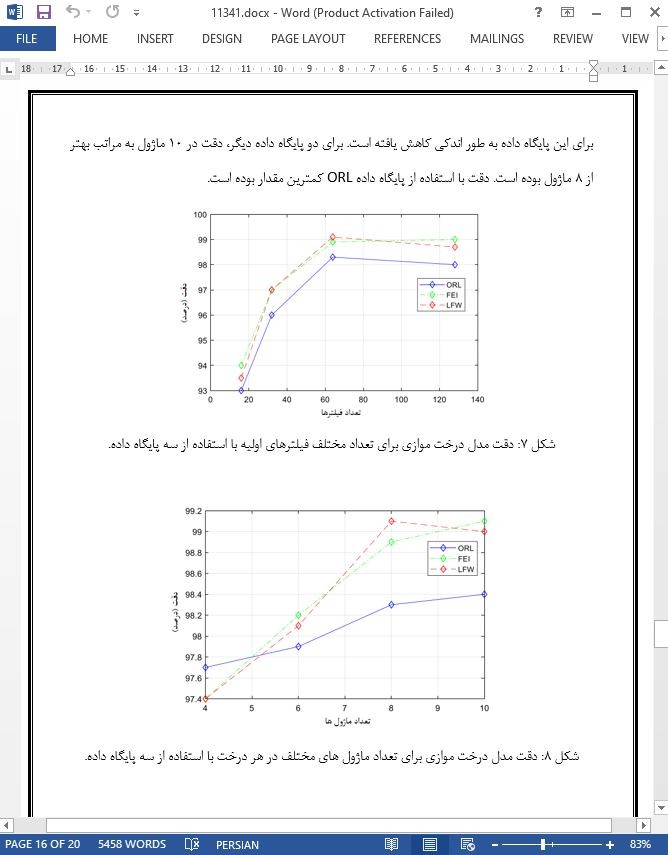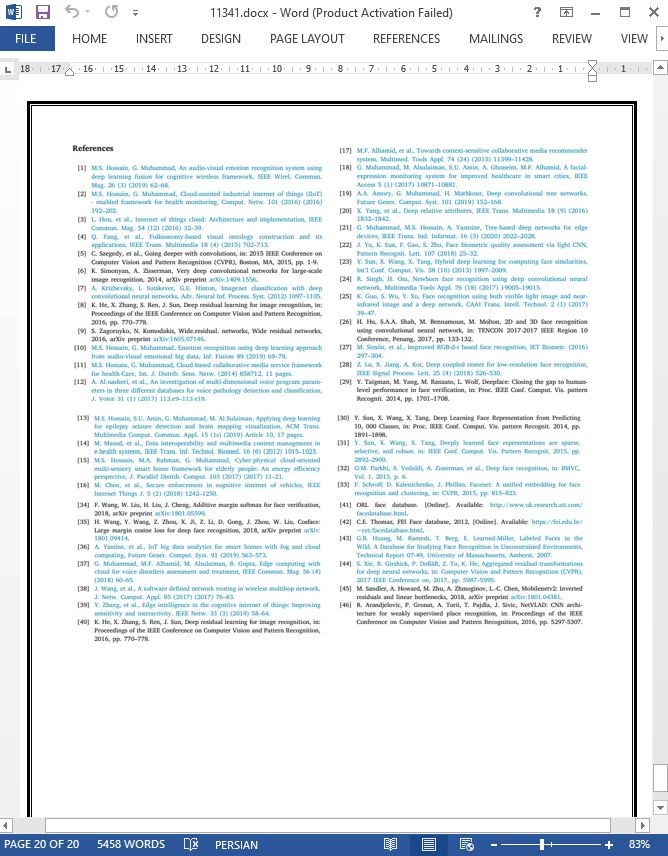
تشخیص چهره هوشمند مبتنی بر یادگیری عمیق در محیط ابری- اینترنت اشیا
چکیده
در سال های اخیر فناوری اینترنت اشیا (IoT) در حوزه های عملیاتی بسیاری همانند مراقبت از سلامت، نظارت ویدیویی، حمل و نقل و غیره به کار گرفته شده است. پذیرش و رشد عظیم اینترنت اشیا در این حوزه ها در حال تولید میزان بزرگی از داده ها است. به عنوان مثال، تجهیزات اینترنت اشیا همانند دوربین ها مقادیر عظیمی از تصاویر را در حین استفاده در سناریوهای نظارت بیمارستانی تولید می کنند. در اینجا تشخیص چهره عنصر مهمی است که برای امن کردن تجهیزات بیمارستانی، تشخیص عواطف و تحلیل احساسات بیماران، تشخیص تقلب بیمار و تحلیل الگوی ترافیک بیمارستان قابل استفاده هستند. سیستم های خودکار و هوشمند تشخیص چهره دارای دقت زیادی در یک محیط کنترل شده هستند؛ با این حال، آن ها دقت کمی در محیطی بدون کنترل دارند. همچنین این سیستم ها می بایست به صورت لحظه ای در کاربردهای بسیاری همانند بهداشت و درمان هوشمند کار کنند. این مقاله یک مدل عمیق مبتنی بر درخت را برای تشخیص چهره خودکار در یک محیط ابری پیشنهاد می کند. این مدل عمیق پیشنهادی دارای بار محاسباتی کمتری است و دقت را از بین نمی برد. در این مدل یک حجم ورودی به چندین حجم تقسیم می شود به طوری که درختی برای هر حجم ساخته می شود. یک درخت توسط ضریب شاخه سازی و ارتفاعش تعریف می شود. هر شاخه توسط یک تابع باقیمانده نمایش داده می شود که شامل یک لایه کانولوشنی، نرمالیزه سازی دسته ای و یک تابع غیرخطی است. این مدل پیشنهادی در پایگاه داده های عمومی مختلفی ارزیابی می شود. مقایسه ای از عملکرد توسط بهترین مدل های عمیق برای تشخیص چهره انجام می شود. نتایج حاصل از این آزمایش ها نشان می دهد که مدل پیشنهادی به دقت های 98.65، 99.19 و 95.84 درصد به ترتیب در پایگاه داده های FEI، ORL و LFW دست یافته است.
5. نتیجه گیری
مدل های عمیق مبتنی بر درخت برای تشخیص چهره در این مقاله پیشنهاد شده است. دو نسخه مدل پیشنهادی وجود دارد: درخت تک و درخت های موازی. در مدل درخت های موازی، چندین درخت تک به صورت موازی ترتیب داده شده است. تابع باقی مانده به عنوان بلوک سازنده کل معماری مورد استفاده قرار گرفته است. آزمایش ها با استفاده از سه پایگاه داده چهره عمومی انجام شده است که به صورت عمومی در دسترس قرار دارند. مدل های پیشنهادی به دقت 99 درصد توسط این پایگاه داده ها دست یافته اند. چگالی اطلاعات مربوط به مدل پیشنهادی مبتنی بر درخت تک حدود 0.6 بوده است که برای یک مدل عمیق عالی است. در مقایسه با مدل های عمیق موجود، مدل های پیشنهادی دارای دقت قابل توجهی با تعداد کمتر پارامترها بوده اند. این یافته ها ثابت می کنند که مدل های پیشنهادی می توانند به طور کارآمد به عنوان یک سیستم تشخیص چهره در کاربردهای امنیتی مورد استفاده قرار گیرند. جهت گیری های آتی کار پیشنهادی می تواند به این صورت باشد. اول، مدل های پیشنهادی می توانند توسعه داده شوند تا مولفه های بیشتری همانند توصیف کننده های تجمیع محلی [46] را در عوض پیوستگی مورد استفاده در این مدل ها در بر بگیرند. دوم، پایگاه داده بیشتری در این آزمایش ها در نظر گرفته می شود. سوم، مدل های پیشنهادی در کاربردهای دیگری همانند تشخیص جنسیت و تشخیص احساسات چهره قابل استفاده هستند.
Abstract
In recent years, the Internet-of-Things (IoT) technology is being used in many application areas such as healthcare, video surveillance, transportation etc. The massive adoption and growth of IoT in these areas are generating a massive amount of data. For example, IoT devices such as cameras are generating a huge amount of images when used in hospital surveillance scenarios. Here, face recognition is an important element that can be used for securing hospital facilities, emotion detection and sentiment analysis of patients, detecting patient fraud, and hospital traffic pattern analysis. Automatic and intelligent face recognition systems have high accuracy in a controlled environment; however, they have low accuracy in an uncontrolled environment. Also, the systems need to operate in real-time in many applications such as smart healthcare. This paper suggests a tree-based deep model for automatic face recognition in a cloud environment. The proposed deep model is computationally less expensive without compromising the accuracy. In the model, an input volume is split into several volumes, where a tree is constructed for each volume. A tree is defined by its branching factor and height. Each branch is represented by a residual function, which is constituted by a convolutional layer, a batch normalization, and a non-linear function. The proposed model is evaluated in various publicly available databases. A comparison of performance is also done with state-of-the-art deep models for face recognition. The results of the experiments demonstrate that the proposed model achieved accuracies of 98.65%, 99.19%, 95.84% on FEI, ORL, and LFW databases, respectively.
5. Conclusion
The tree-based deep models for face recognition were proposed in this paper. There were two versions of the proposed model: single tree and parallel trees. In the parallel trees model, several single trees were arranged in parallel. The residual function was used as the building block of the whole architecture. Experiments were performed using three publicly available face databases. The proposed models achieved around 99% accuracy using these databases. The information density of the proposed single tree-based model was near 0.6, which is considered excellent for a deep model. Compared to the existing deep models, the proposed models had comparable accuracies with a lesser number of parameters. These findings prove that the proposed models can be efficiently used as a face recognition system in real-time for security purposes. The future directions of the proposed work can be as follows. First, the proposed models can be extended to include more components such as the locally aggregated descriptors [46] instead of the concatenation used in the models. Second, more databases can be included in the experiments. Third, the proposed models can be used in other applications such as gender recognition and facial emotion recognition.
چکیده
1. مقدمه
2. مطالعات مرتبط
3. نیازمندی ها و روش ها
3-1 چارچوب شهر هوشمند
3-2 شبکه عمیق مبتنی بر درخت
3-3 پایگاه داده
4. نتایج تجربی و بحث
5. نتیجه گیری
ABSTRACT
1. Introduction
2. Related studies
3. Materials and methods
3.1. Smart city framework
3.2. Tree-based deep network
3.3. Database
4. Experimental results and discussion
5. Conclusion
- اصل مقاله انگلیسی با فرمت ورد (word) با قابلیت ویرایش
- ترجمه فارسی مقاله با فرمت ورد (word) با قابلیت ویرایش، بدون آرم سایت ای ترجمه
- ترجمه فارسی مقاله با فرمت pdf، بدون آرم سایت ای ترجمه



